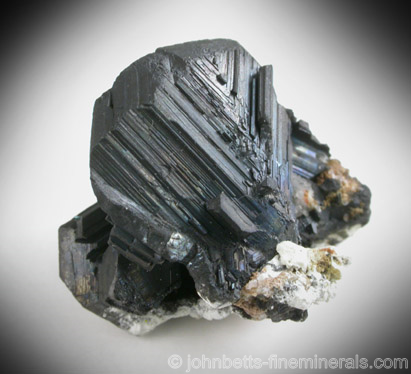The Mineral chalcocite

Chalcocite is a coveted and iconic mineral among collectors. Specimens from classic and extinct localities, such as Cornwall, England and Bristol, Connecticut, will command extremely high prices, especially when in good crystals.
Chalcocite forms from the
alteration of other minerals, especially other copper
sulfides such as
Bornite,
Covellite, and
Chalcopyrite, and may also form
pseudomorphs after these minerals. It often forms in association with
Chrysocolla, with the Chrysocolla forming as an alteration around the Chalcocite. Chalcocite is named after the Greek word
chalcos, which means "copper" in Greek, in allusion to the copper content in this mineral.
Color
Gray to black, often with a bluish tinge. Sometimes iridescent with a bluish or purplish tinge.
Crystal System
Orthorhombic
Properties
Streak
Dark gray. Streak may be shiny. |
Hardness
2.5 - 3 |
Transparency
Opaque |
Specific Gravity
5.5 - 5.8 |
Luster
Metallic |
Cleavage
3,1 |
Fracture
Conchoidal |
Tenacity
Brittle |
Other ID Marks
May develop a thin film layer on crystal faces.
|
Varieties
-
Chalcocite from the Redruth area in Cornwall, England.
Uses
Chalcocite is an important copper ore. It has a high copper
content and the process of extracting the copper from the sulfur in Chalcocite is relatively easily. Chalcocite is also an important collector's mineral, and good crystals command very high prices.
Noteworthy Localities
In Europe, a classic Chalcocite locality is Cornwall, England. Several well-known Cornish occurrences include the Carn Brea area; the
Geevor Mine; the Levant Mine; and St Ives. Two African Chalcocite localities of note are Tsumeb, Namibia; and Shaba, Congo (Zaire). A relatively new Asian occurrence is the copper deposit of Dzhezkazgan, Kazakhstan. An odd new form of Chalcocite with iridescent root-like growths has been recently described from the Tongshan Mine, Nenjiang, China. Large, well-formed crystals come from the Mammoth Mine, Mount Isa, Queensland, Australia.
In the U.S., the best Chalcocite crystals once came from the old mine operations at Bristol, Hartford County, Connecticut. Another classic locality is Butte, Silver Bow Co., Montana. A new Chalcocite finding in the 1990's in the Flambeau Mine, Ladysmith, Rusk Co., Wisconsin, had yielded some excellent crystals. Other notable U.S. finds are the Santa Rita Mine, Grant Co., New Mexico;
Bisbee, Cochise Co., Arizona; and the
Chimney Rock Quarry, Bound Brook, Somerset Co., New Jersey.
Distingushing Similar Minerals
Galena - Different crystals and cleavage.
Acanthite - Is more sectile.